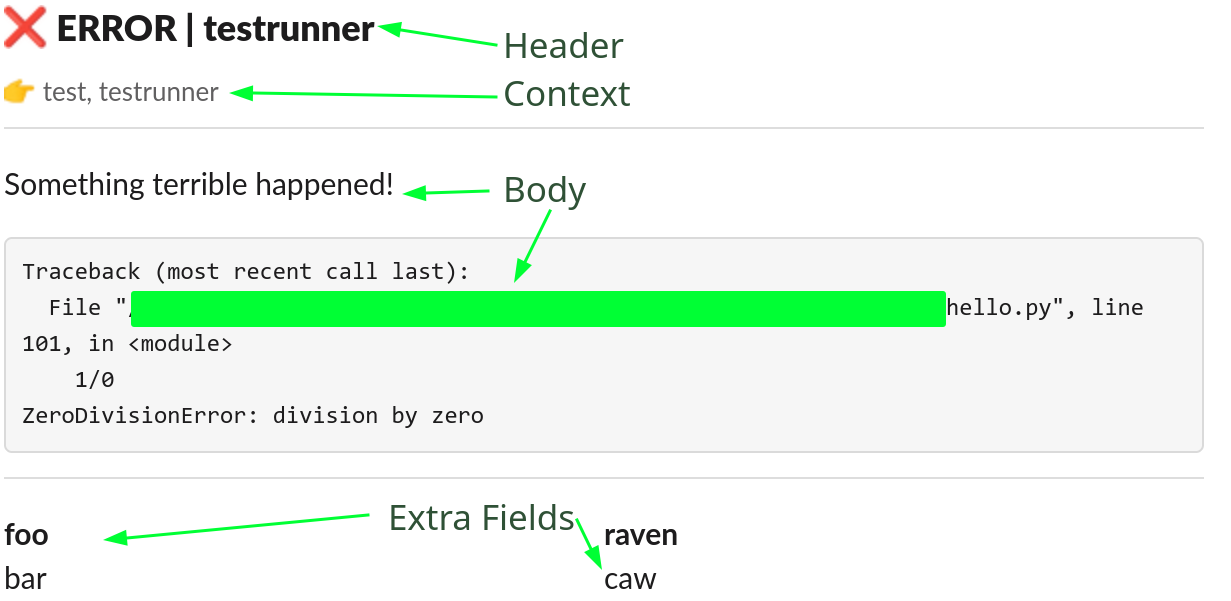Slack logger utilizing python logging interface.
Project description
Slack Logger Python - A Slack Logger for Python Logging
A python logging implementation to send messages to Slack. Design goals:
- Use Python logging interface such that it can be integrated with standard logging tools.
- Fully customizable messages with full control over message layout and design.
- Simple authentication via webhook.
- Powerful filtering to filter e.g. for environments or particular values only known at runtime.
- Easy usage to cover most use cases when slack is used for basic alerting and automatic traceback visualization.
To achieve aforementioned goals, the library provides logging handler, formatter and filter implementations.
Getting Started
- Install with
pip install slack-logger-python. - Now, you can use the
slack_loggermodule in your python code.
Basic Example with Plain Messages
This basic examples shows the usage and the implementation of design goal (1) and (3).
from slack_logger import SlackFormatter, SlackHandler
logger = logging.getLogger(__name__)
formatter = SlackFormatter.plain() # plain message, no decorations
handler = SlackHandler.from_webhook(os.environ["SLACK_WEBHOOK"])
handler.setFormatter(formatter)
handler.setLevel(logging.WARN)
logger.addHandler(handler)
logger.info("I won't appear.")
logger.warning("I will show up.")
logger.error("Mee too.")
Visually Appealing Messages
You can use the SlackFormatter.minimal() and SlackFormatter.default() formatter for more visually appealing log messages.
For now, those require a configuration to show e.g. the header.
Extra fields are shown in blocks at the bottom of the message and can be dynamically added at runtime.
Everything else stays the same:
from slack_logger import Configuration, SlackFormatter, SlackHandler
logger = logging.getLogger(__name__)
config = Configuration(service="testrunner", environment="test", extra_fields={"foo": "bar"})
formatter = SlackFormatter.default(config)
handler = SlackHandler.from_webhook(os.environ["SLACK_WEBHOOK"])
handler.setFormatter(formatter)
handler.setLevel(logging.WARN)
logger.addHandler(handler)
logger.info("I won't appear.")
logger.warning("I will show up.")
logger.error("Mee too.")
Adding extra fields on single log message is achieved by just putting it in the extra fields of the logging interface:
logger.warning("I will show up.", extra = {"extra_fields": {"foo": "baba"}})
Customization
To do basic customizations, you can provide a configuration to the SlackFormatter:
service: Optional[str] = None
environment: Optional[str] = None
context: List[str] = []
emojis: Dict[int, str] = DEFAULT_EMOJIS
extra_fields: Dict[str, str] = {}
Let's look at an example error log from a division by zero error. Given the following code snippet with a configuration and the default formatter:
import os
from slack_logger import Configuration, SlackFormatter, SlackHandler
service_config = Configuration(
service="testrunner", environment="test", extra_fields={"foo": "bar", "raven": "caw"}
)
slack_handler = SlackHandler.from_webhook(os.environ["SLACK_WEBHOOK"])
formatter = SlackFormatter.default(service_config)
slack_handler.setFormatter(formatter)
log.addHandler(slack_handler)
try:
1/0
except Exception:
log.exception("Something terrible happened!")
We will get the following error message in slack:
It contains a header, a context, a body and a section containing extra fields. Let's identify those in the image above.
The header is composed of:
- Log level emoji: ❌
- Log level name: ERROR
- Service name: testrunner
The context contains:
- Environment: test
- Service name: testrunner
The body includes:
- The log error message: "Something terrible happened!"
- The Traceback error
Extra fields:
- Field "foo" with value "bar"
- Field "raven" with value "caw"
Design Message - Design Principal (3)
Messages are fully customizable using slacks block layout, see Creating rich message layouts and Reference: Layout blocks.
By implementing the MessageDesign interface, you can fully control in the message design, which requires you to implement a function format_blocks(record: LogRecord) -> Sequence[Optional[Block]] to transform a LogRecord into a sequence of slack message blocks.
Of course, you can add configurations and helper functions as well.
Let's create our own warning message. This demonstrates the usage and the implementation of design goal (2).
import attrs # for convenience, but not required
from slack_sdk.models.blocks import Block, DividerBlock, HeaderBlock, SectionBlock
from slack_logger import SlackFormatter
@define
class CustomDesign(MessageDesign):
def format_blocks(self, record: LogRecord) -> Sequence[Optional[Block]]:
level = record.levelname
message = record.getMessage()
blocks: Sequence[Block] = [
HeaderBlock(text=PlainTextObject(text=f"{level} {message}")),
DividerBlock(),
SectionBlock(text=MarkdownTextObject(text=message)),
]
return blocks
formatter = SlackFormatter(design=CustomDesign())
Provide your own set of emojis
To the default emoji set is a defined by the following dict:
DEFAULT_EMOJIS = {
logging.CRITICAL: ":fire:", # 🔥
logging.ERROR: ":x:", # ❌
logging.FATAL: ":x:", # ❌
logging.WARNING: ":warning:", # ⚠️
logging.WARN: ":warning:", # ⚠️
logging.INFO: ":bell:", # 🔔
logging.DEBUG: ":microscope:", # 🔬
logging.NOTSET: ":mega:", # 📣
}
You can import and overwrite it partially, or define a complete new set of emoji.
The following example demonstrates how you can add the emoji set to the SlackFormatter:
from slack_logger import Configuration, SlackFormatter
my_emojis = {
logging.CRITICAL: ":x:", # ❌
logging.ERROR: ":x:", # ❌
logging.FATAL: ":x:", # ❌
logging.WARNING: ":bell:", # 🔔
logging.WARN: ":bell:", # 🔔
logging.INFO: ":mega:", # 📣
logging.DEBUG: ":mega:", # 📣
logging.NOTSET: ":mega:", # 📣
}
config = Configuration(service="testrunner", environment="test", emojis=my_emojis)
formatter = SlackFormatter.default(config)
Filter Message
Filters implement the logging interface of Filters.
Design goal (4) and (5) are partially demonstrated.
from slack_logger import Configuration, SlackFilter, SlackHandler
import os
import logging
logger = logging.getLogger("ProdFilter")
# Allow only logs from `prod` environment
filter = SlackFilter(config=Configuration(environment="prod"), filterType=FilterType.AnyWhitelist)
slack_handler.addFilter(filter)
logger.addHandler(slack_handler)
# When the ENV enviroment variable is set to prod, the message will be send.
# Otherwise, the message is filtered out and not send (e.g. if ENV is `dev`)
logger.warning(f"{log_msg} in some environment and whitelisted prod", extra={"filter": {"environment": os.getenv("ENV", "dev")}})
# Will be filtered
logger.warning(f"{log_msg} in dev environment and whitelisted prod", extra={"filter": {"environment": "dev"}})
# Will be send
logger.warning(f"{log_msg} in dev environment and whitelisted prod", extra={"filter": {"environment": "prod"}})
The composition of configurations, filters and dynamic extra fields allow for a flexible way of specifying your message content and filter unwanted messages.
Project details
Release history Release notifications | RSS feed
Download files
Download the file for your platform. If you're not sure which to choose, learn more about installing packages.
Source Distribution
Built Distribution
Hashes for slack-logger-python-0.2.9.tar.gz
| Algorithm | Hash digest | |
|---|---|---|
| SHA256 | 103959f6692ff4e76ca6ac330cc946034f5e378be2e3130e20c86fffb5490acb |
|
| MD5 | 545ace5faf8eb2a0f5c717d1c2313067 |
|
| BLAKE2b-256 | ac3c6d1ac88c9686d4322ad2d4e877bda05b6378e5bc4aa78dd3d115eac85d0c |
Hashes for slack_logger_python-0.2.9-py3-none-any.whl
| Algorithm | Hash digest | |
|---|---|---|
| SHA256 | 0ca3a3b2891566b32ca6efd8c3aa495629f442d5bd11d9b07aff15123508b03e |
|
| MD5 | 00c24f8e74b76da0ccc8fb5ba61075f1 |
|
| BLAKE2b-256 | 932a35566c7c4b528f11e7d93ed74fccbd55921b1cc52631f5539390dc92dc51 |
















